Disability and Children with Mental Health - Issues, Impact, and Policies
VerifiedAdded on 2023/06/14
|6
|1562
|491
AI Summary
This article discusses the challenges faced by children with disabilities and mental health, their impact on families, and society. It highlights the need for appropriate support and care, the effectiveness of current policies and practices, and the gaps in the NSW system. The article provides insights into the issue of prevalence cost in individual and social issues of disability and mental health, cultural and systematic practices that impact the issues, and the initiatives taken by the World Health Organization to reduce the barriers of disability and other issues.
Contribute Materials
Your contribution can guide someone’s learning journey. Share your
documents today.
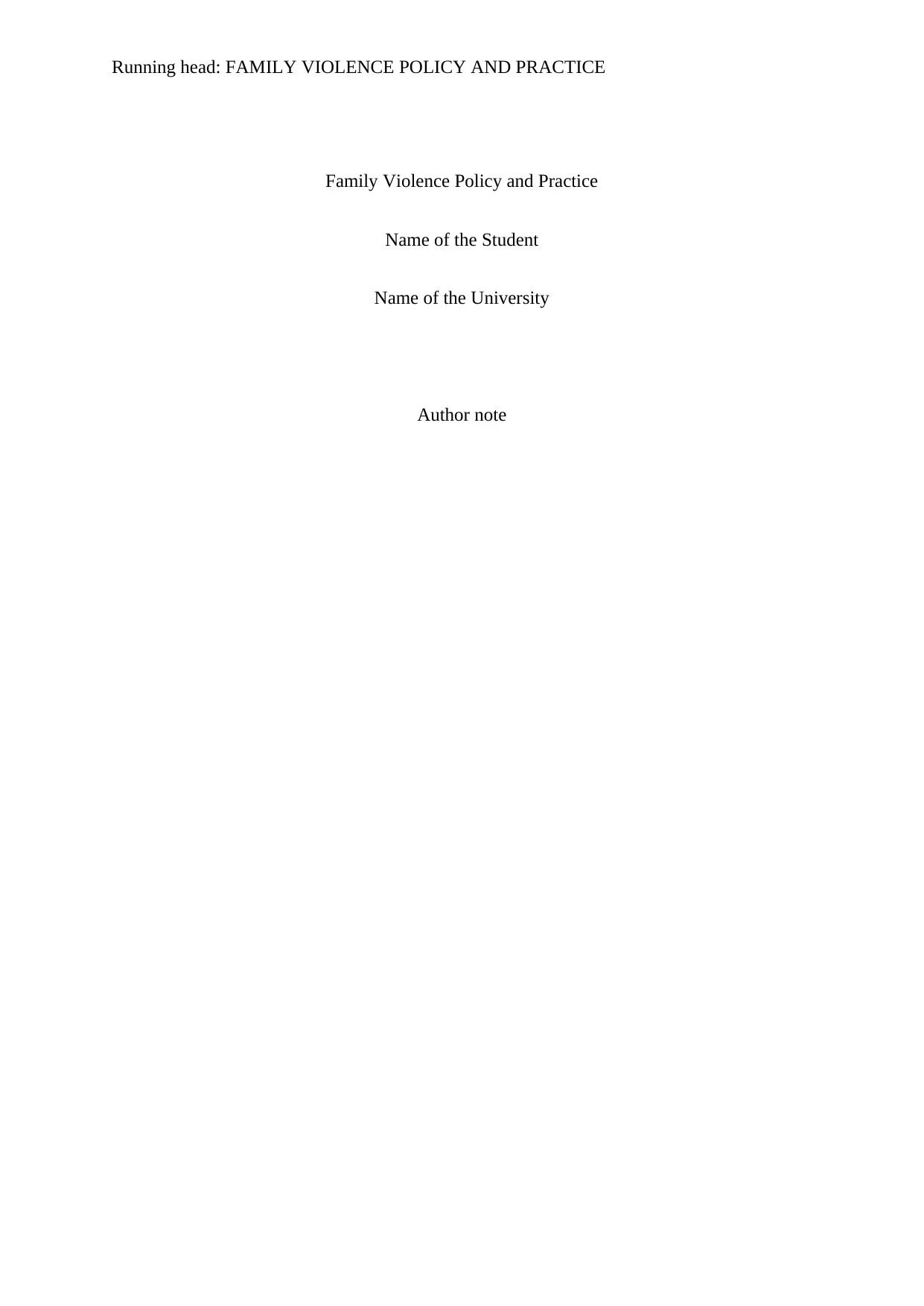
Running head: FAMILY VIOLENCE POLICY AND PRACTICE
Family Violence Policy and Practice
Name of the Student
Name of the University
Author note
Family Violence Policy and Practice
Name of the Student
Name of the University
Author note
Secure Best Marks with AI Grader
Need help grading? Try our AI Grader for instant feedback on your assignments.
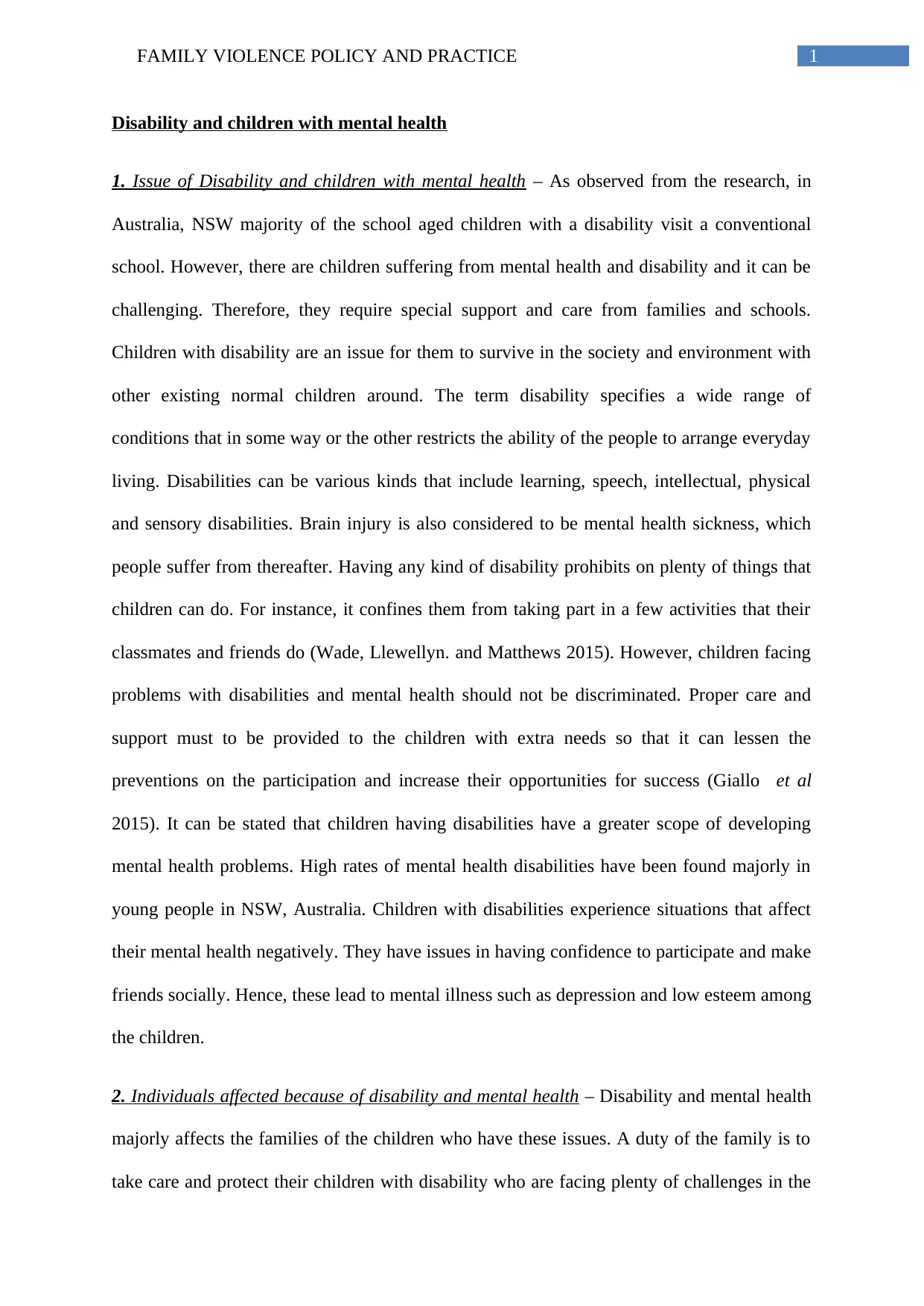
1FAMILY VIOLENCE POLICY AND PRACTICE
Disability and children with mental health
1. Issue of Disability and children with mental health – As observed from the research, in
Australia, NSW majority of the school aged children with a disability visit a conventional
school. However, there are children suffering from mental health and disability and it can be
challenging. Therefore, they require special support and care from families and schools.
Children with disability are an issue for them to survive in the society and environment with
other existing normal children around. The term disability specifies a wide range of
conditions that in some way or the other restricts the ability of the people to arrange everyday
living. Disabilities can be various kinds that include learning, speech, intellectual, physical
and sensory disabilities. Brain injury is also considered to be mental health sickness, which
people suffer from thereafter. Having any kind of disability prohibits on plenty of things that
children can do. For instance, it confines them from taking part in a few activities that their
classmates and friends do (Wade, Llewellyn. and Matthews 2015). However, children facing
problems with disabilities and mental health should not be discriminated. Proper care and
support must to be provided to the children with extra needs so that it can lessen the
preventions on the participation and increase their opportunities for success (Giallo et al
2015). It can be stated that children having disabilities have a greater scope of developing
mental health problems. High rates of mental health disabilities have been found majorly in
young people in NSW, Australia. Children with disabilities experience situations that affect
their mental health negatively. They have issues in having confidence to participate and make
friends socially. Hence, these lead to mental illness such as depression and low esteem among
the children.
2. Individuals affected because of disability and mental health – Disability and mental health
majorly affects the families of the children who have these issues. A duty of the family is to
take care and protect their children with disability who are facing plenty of challenges in the
Disability and children with mental health
1. Issue of Disability and children with mental health – As observed from the research, in
Australia, NSW majority of the school aged children with a disability visit a conventional
school. However, there are children suffering from mental health and disability and it can be
challenging. Therefore, they require special support and care from families and schools.
Children with disability are an issue for them to survive in the society and environment with
other existing normal children around. The term disability specifies a wide range of
conditions that in some way or the other restricts the ability of the people to arrange everyday
living. Disabilities can be various kinds that include learning, speech, intellectual, physical
and sensory disabilities. Brain injury is also considered to be mental health sickness, which
people suffer from thereafter. Having any kind of disability prohibits on plenty of things that
children can do. For instance, it confines them from taking part in a few activities that their
classmates and friends do (Wade, Llewellyn. and Matthews 2015). However, children facing
problems with disabilities and mental health should not be discriminated. Proper care and
support must to be provided to the children with extra needs so that it can lessen the
preventions on the participation and increase their opportunities for success (Giallo et al
2015). It can be stated that children having disabilities have a greater scope of developing
mental health problems. High rates of mental health disabilities have been found majorly in
young people in NSW, Australia. Children with disabilities experience situations that affect
their mental health negatively. They have issues in having confidence to participate and make
friends socially. Hence, these lead to mental illness such as depression and low esteem among
the children.
2. Individuals affected because of disability and mental health – Disability and mental health
majorly affects the families of the children who have these issues. A duty of the family is to
take care and protect their children with disability who are facing plenty of challenges in the
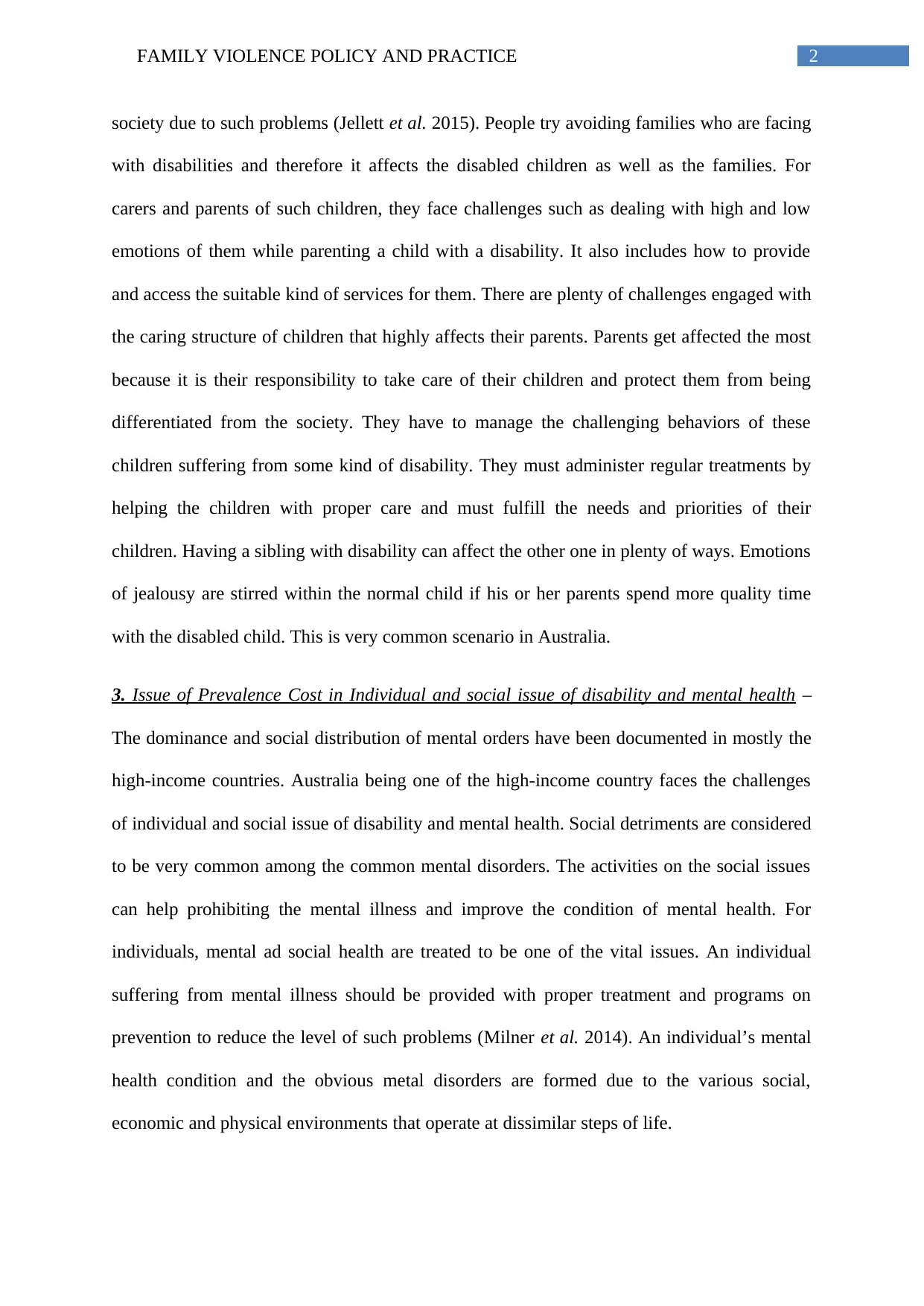
2FAMILY VIOLENCE POLICY AND PRACTICE
society due to such problems (Jellett et al. 2015). People try avoiding families who are facing
with disabilities and therefore it affects the disabled children as well as the families. For
carers and parents of such children, they face challenges such as dealing with high and low
emotions of them while parenting a child with a disability. It also includes how to provide
and access the suitable kind of services for them. There are plenty of challenges engaged with
the caring structure of children that highly affects their parents. Parents get affected the most
because it is their responsibility to take care of their children and protect them from being
differentiated from the society. They have to manage the challenging behaviors of these
children suffering from some kind of disability. They must administer regular treatments by
helping the children with proper care and must fulfill the needs and priorities of their
children. Having a sibling with disability can affect the other one in plenty of ways. Emotions
of jealousy are stirred within the normal child if his or her parents spend more quality time
with the disabled child. This is very common scenario in Australia.
3. Issue of Prevalence Cost in Individual and social issue of disability and mental health –
The dominance and social distribution of mental orders have been documented in mostly the
high-income countries. Australia being one of the high-income country faces the challenges
of individual and social issue of disability and mental health. Social detriments are considered
to be very common among the common mental disorders. The activities on the social issues
can help prohibiting the mental illness and improve the condition of mental health. For
individuals, mental ad social health are treated to be one of the vital issues. An individual
suffering from mental illness should be provided with proper treatment and programs on
prevention to reduce the level of such problems (Milner et al. 2014). An individual’s mental
health condition and the obvious metal disorders are formed due to the various social,
economic and physical environments that operate at dissimilar steps of life.
society due to such problems (Jellett et al. 2015). People try avoiding families who are facing
with disabilities and therefore it affects the disabled children as well as the families. For
carers and parents of such children, they face challenges such as dealing with high and low
emotions of them while parenting a child with a disability. It also includes how to provide
and access the suitable kind of services for them. There are plenty of challenges engaged with
the caring structure of children that highly affects their parents. Parents get affected the most
because it is their responsibility to take care of their children and protect them from being
differentiated from the society. They have to manage the challenging behaviors of these
children suffering from some kind of disability. They must administer regular treatments by
helping the children with proper care and must fulfill the needs and priorities of their
children. Having a sibling with disability can affect the other one in plenty of ways. Emotions
of jealousy are stirred within the normal child if his or her parents spend more quality time
with the disabled child. This is very common scenario in Australia.
3. Issue of Prevalence Cost in Individual and social issue of disability and mental health –
The dominance and social distribution of mental orders have been documented in mostly the
high-income countries. Australia being one of the high-income country faces the challenges
of individual and social issue of disability and mental health. Social detriments are considered
to be very common among the common mental disorders. The activities on the social issues
can help prohibiting the mental illness and improve the condition of mental health. For
individuals, mental ad social health are treated to be one of the vital issues. An individual
suffering from mental illness should be provided with proper treatment and programs on
prevention to reduce the level of such problems (Milner et al. 2014). An individual’s mental
health condition and the obvious metal disorders are formed due to the various social,
economic and physical environments that operate at dissimilar steps of life.
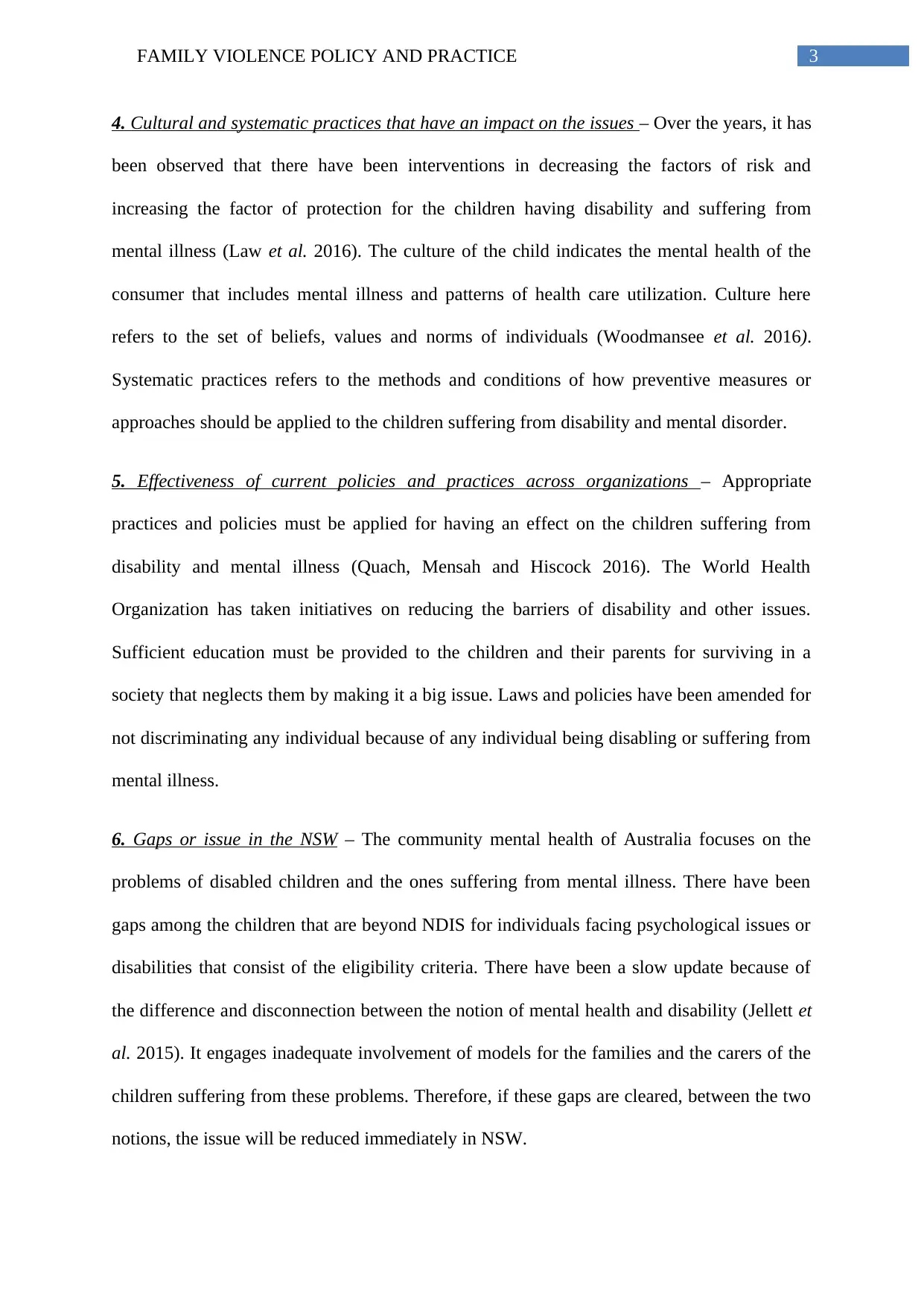
3FAMILY VIOLENCE POLICY AND PRACTICE
4. Cultural and systematic practices that have an impact on the issues – Over the years, it has
been observed that there have been interventions in decreasing the factors of risk and
increasing the factor of protection for the children having disability and suffering from
mental illness (Law et al. 2016). The culture of the child indicates the mental health of the
consumer that includes mental illness and patterns of health care utilization. Culture here
refers to the set of beliefs, values and norms of individuals (Woodmansee et al. 2016).
Systematic practices refers to the methods and conditions of how preventive measures or
approaches should be applied to the children suffering from disability and mental disorder.
5. Effectiveness of current policies and practices across organizations – Appropriate
practices and policies must be applied for having an effect on the children suffering from
disability and mental illness (Quach, Mensah and Hiscock 2016). The World Health
Organization has taken initiatives on reducing the barriers of disability and other issues.
Sufficient education must be provided to the children and their parents for surviving in a
society that neglects them by making it a big issue. Laws and policies have been amended for
not discriminating any individual because of any individual being disabling or suffering from
mental illness.
6. Gaps or issue in the NSW – The community mental health of Australia focuses on the
problems of disabled children and the ones suffering from mental illness. There have been
gaps among the children that are beyond NDIS for individuals facing psychological issues or
disabilities that consist of the eligibility criteria. There have been a slow update because of
the difference and disconnection between the notion of mental health and disability (Jellett et
al. 2015). It engages inadequate involvement of models for the families and the carers of the
children suffering from these problems. Therefore, if these gaps are cleared, between the two
notions, the issue will be reduced immediately in NSW.
4. Cultural and systematic practices that have an impact on the issues – Over the years, it has
been observed that there have been interventions in decreasing the factors of risk and
increasing the factor of protection for the children having disability and suffering from
mental illness (Law et al. 2016). The culture of the child indicates the mental health of the
consumer that includes mental illness and patterns of health care utilization. Culture here
refers to the set of beliefs, values and norms of individuals (Woodmansee et al. 2016).
Systematic practices refers to the methods and conditions of how preventive measures or
approaches should be applied to the children suffering from disability and mental disorder.
5. Effectiveness of current policies and practices across organizations – Appropriate
practices and policies must be applied for having an effect on the children suffering from
disability and mental illness (Quach, Mensah and Hiscock 2016). The World Health
Organization has taken initiatives on reducing the barriers of disability and other issues.
Sufficient education must be provided to the children and their parents for surviving in a
society that neglects them by making it a big issue. Laws and policies have been amended for
not discriminating any individual because of any individual being disabling or suffering from
mental illness.
6. Gaps or issue in the NSW – The community mental health of Australia focuses on the
problems of disabled children and the ones suffering from mental illness. There have been
gaps among the children that are beyond NDIS for individuals facing psychological issues or
disabilities that consist of the eligibility criteria. There have been a slow update because of
the difference and disconnection between the notion of mental health and disability (Jellett et
al. 2015). It engages inadequate involvement of models for the families and the carers of the
children suffering from these problems. Therefore, if these gaps are cleared, between the two
notions, the issue will be reduced immediately in NSW.
Secure Best Marks with AI Grader
Need help grading? Try our AI Grader for instant feedback on your assignments.
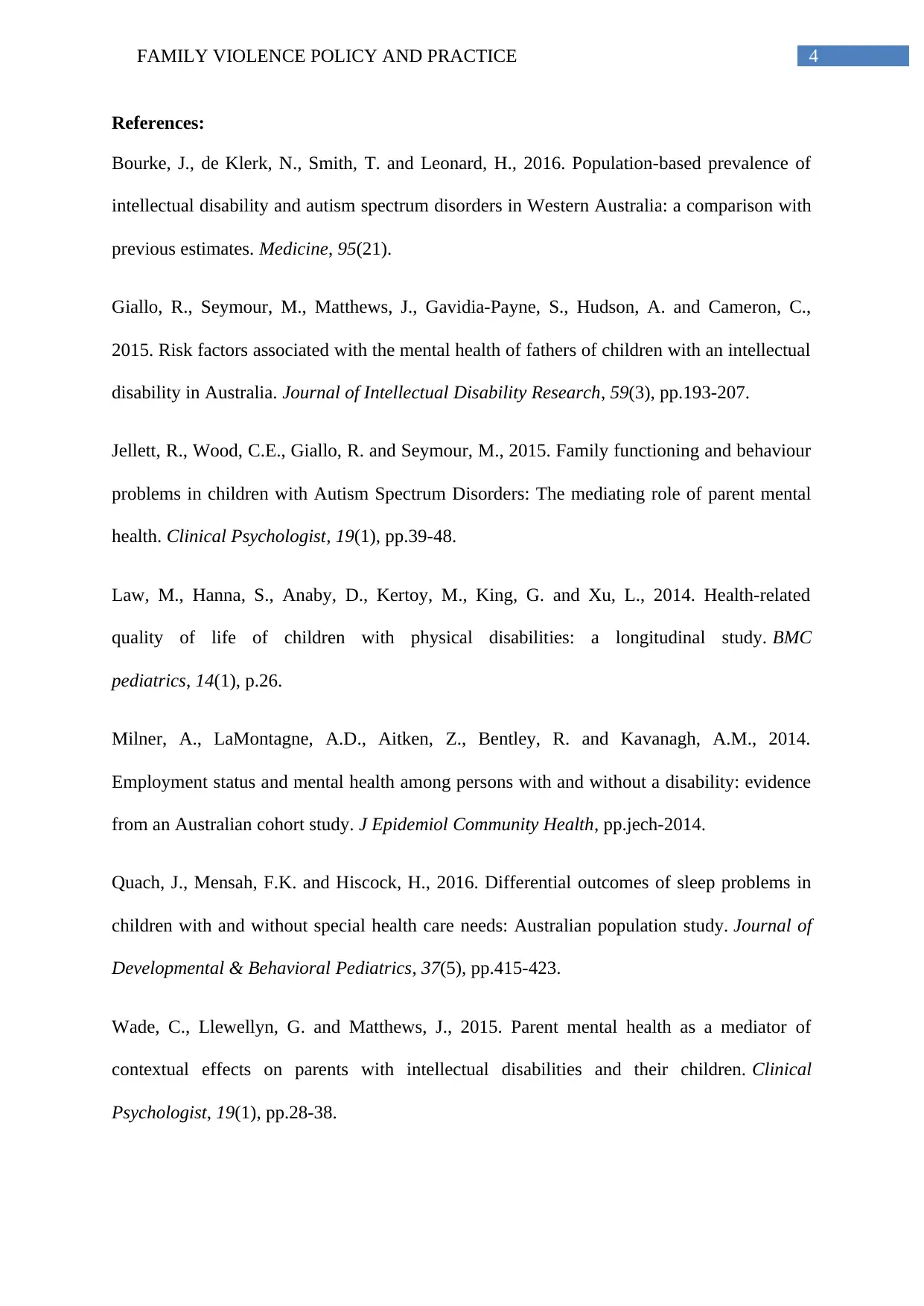
4FAMILY VIOLENCE POLICY AND PRACTICE
References:
Bourke, J., de Klerk, N., Smith, T. and Leonard, H., 2016. Population-based prevalence of
intellectual disability and autism spectrum disorders in Western Australia: a comparison with
previous estimates. Medicine, 95(21).
Giallo, R., Seymour, M., Matthews, J., Gavidia‐Payne, S., Hudson, A. and Cameron, C.,
2015. Risk factors associated with the mental health of fathers of children with an intellectual
disability in Australia. Journal of Intellectual Disability Research, 59(3), pp.193-207.
Jellett, R., Wood, C.E., Giallo, R. and Seymour, M., 2015. Family functioning and behaviour
problems in children with Autism Spectrum Disorders: The mediating role of parent mental
health. Clinical Psychologist, 19(1), pp.39-48.
Law, M., Hanna, S., Anaby, D., Kertoy, M., King, G. and Xu, L., 2014. Health-related
quality of life of children with physical disabilities: a longitudinal study. BMC
pediatrics, 14(1), p.26.
Milner, A., LaMontagne, A.D., Aitken, Z., Bentley, R. and Kavanagh, A.M., 2014.
Employment status and mental health among persons with and without a disability: evidence
from an Australian cohort study. J Epidemiol Community Health, pp.jech-2014.
Quach, J., Mensah, F.K. and Hiscock, H., 2016. Differential outcomes of sleep problems in
children with and without special health care needs: Australian population study. Journal of
Developmental & Behavioral Pediatrics, 37(5), pp.415-423.
Wade, C., Llewellyn, G. and Matthews, J., 2015. Parent mental health as a mediator of
contextual effects on parents with intellectual disabilities and their children. Clinical
Psychologist, 19(1), pp.28-38.
References:
Bourke, J., de Klerk, N., Smith, T. and Leonard, H., 2016. Population-based prevalence of
intellectual disability and autism spectrum disorders in Western Australia: a comparison with
previous estimates. Medicine, 95(21).
Giallo, R., Seymour, M., Matthews, J., Gavidia‐Payne, S., Hudson, A. and Cameron, C.,
2015. Risk factors associated with the mental health of fathers of children with an intellectual
disability in Australia. Journal of Intellectual Disability Research, 59(3), pp.193-207.
Jellett, R., Wood, C.E., Giallo, R. and Seymour, M., 2015. Family functioning and behaviour
problems in children with Autism Spectrum Disorders: The mediating role of parent mental
health. Clinical Psychologist, 19(1), pp.39-48.
Law, M., Hanna, S., Anaby, D., Kertoy, M., King, G. and Xu, L., 2014. Health-related
quality of life of children with physical disabilities: a longitudinal study. BMC
pediatrics, 14(1), p.26.
Milner, A., LaMontagne, A.D., Aitken, Z., Bentley, R. and Kavanagh, A.M., 2014.
Employment status and mental health among persons with and without a disability: evidence
from an Australian cohort study. J Epidemiol Community Health, pp.jech-2014.
Quach, J., Mensah, F.K. and Hiscock, H., 2016. Differential outcomes of sleep problems in
children with and without special health care needs: Australian population study. Journal of
Developmental & Behavioral Pediatrics, 37(5), pp.415-423.
Wade, C., Llewellyn, G. and Matthews, J., 2015. Parent mental health as a mediator of
contextual effects on parents with intellectual disabilities and their children. Clinical
Psychologist, 19(1), pp.28-38.
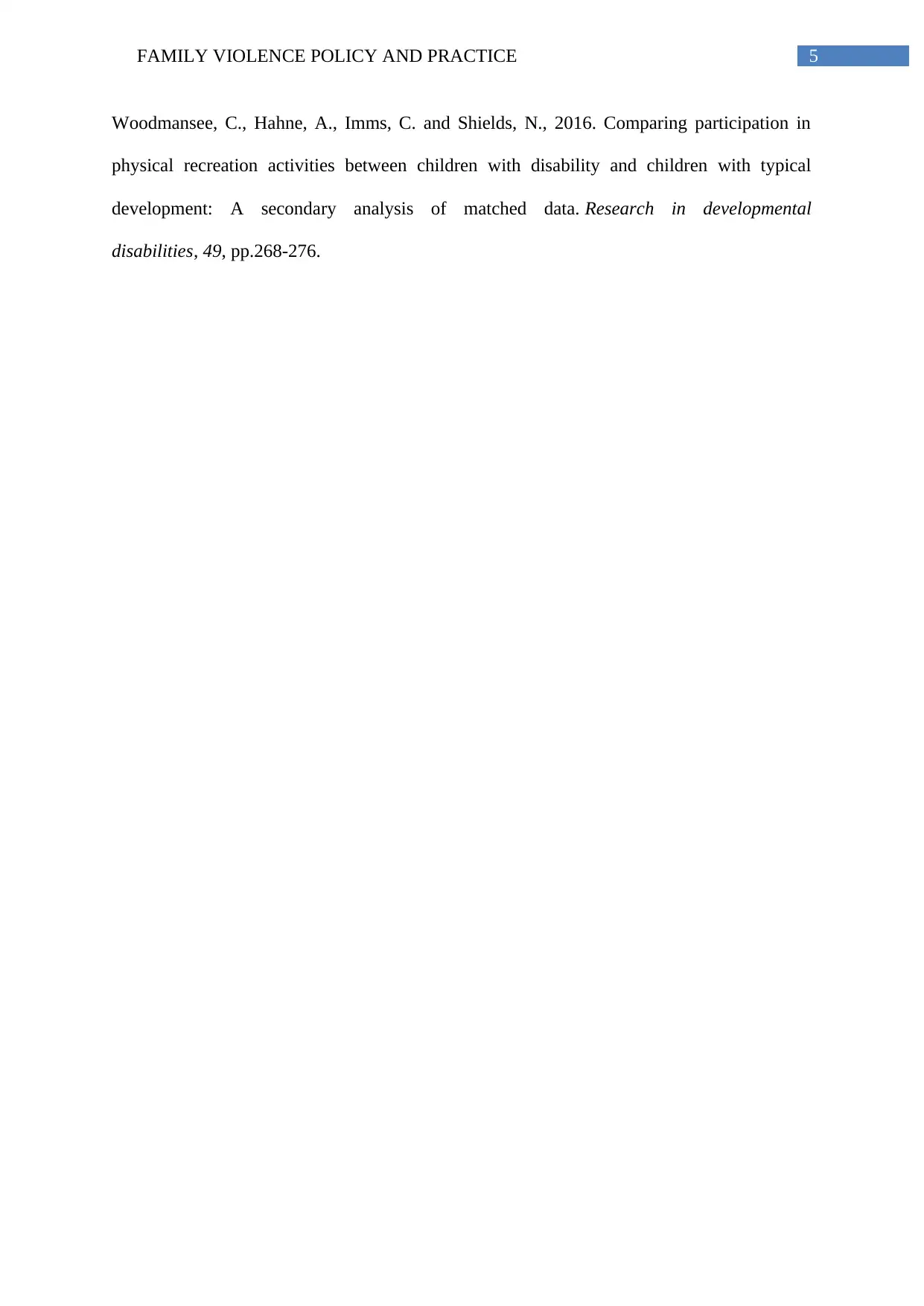
5FAMILY VIOLENCE POLICY AND PRACTICE
Woodmansee, C., Hahne, A., Imms, C. and Shields, N., 2016. Comparing participation in
physical recreation activities between children with disability and children with typical
development: A secondary analysis of matched data. Research in developmental
disabilities, 49, pp.268-276.
Woodmansee, C., Hahne, A., Imms, C. and Shields, N., 2016. Comparing participation in
physical recreation activities between children with disability and children with typical
development: A secondary analysis of matched data. Research in developmental
disabilities, 49, pp.268-276.
1 out of 6
Related Documents
Your All-in-One AI-Powered Toolkit for Academic Success.
+13062052269
info@desklib.com
Available 24*7 on WhatsApp / Email
![[object Object]](/_next/static/media/star-bottom.7253800d.svg)
Unlock your academic potential
© 2024 | Zucol Services PVT LTD | All rights reserved.




